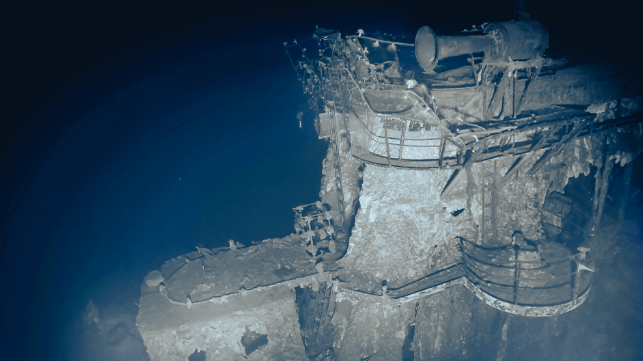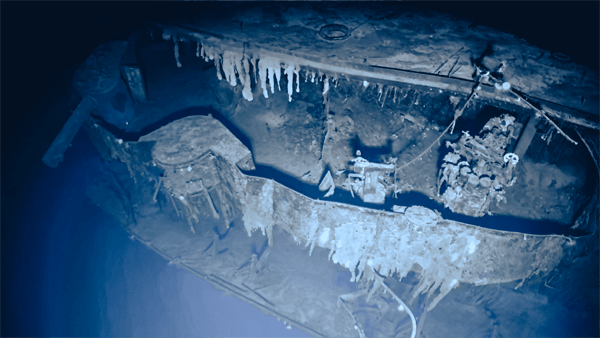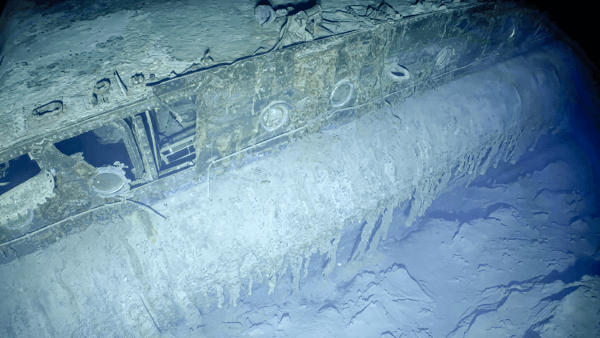Video: Deep Sea Survey Documents Aircraft Carriers Sunk in Battle of Midway

A unique survey mission to explore the wrecks from the critical World War II Battle of Midway was completed earlier this week. They conducted in-depth archaeological assessments of three World War II aircraft carriers lost during the battle, providing remarkable images of the first visual survey of Imperial Japanese Navy (IJN) Akagi, the first detailed views of United States Ship (USS) Yorktown since it was first located 25 years ago, and a comprehensive survey of IJN Kaga.
The surveys were aimed at documenting these historically significant wrecks, examining their condition, and honoring all those who lost their lives on both sides of the battle. The expedition team completed non-invasive visual surveys of the wrecks during three deployments below 5,100 meters (>16,600 feet, 2,770 fathoms), which represent the deepest of the more than 1,000 remotely operated vehicle dives conducted off E/V Nautilus to date.
“This expedition is not only rewriting history and our understanding of these special places but also pushing the limits of what we thought was possible in terms of interdisciplinary collaboration,” says Daniel Wagner, Ph.D., Chief Scientist for Ocean Exploration Trust. “During over 43 hours at depth, we methodically circumnavigated these historic wrecks, bringing to light many features in great detail, including their armament, battle, and sinking-related damage. Many anti-aircraft guns were still pointing up, providing clues about the final moments on these iconic ships.”
.png)
USS Yorktown
The Battle of Midway, which took place from June 4 to 7, 1942 near the island of Midway in the Pacific, is considered by historians to have been one of the decisive battles of the war, crippling the Japanese carrier fleet and starting the United States’ path to victory. It came just six months after the attack on Pearl Harbor in Hawaii and a month after the U.S. stopped the Japanese advance in the Coral Sea but tactically lost the sea battle.
Breaking the Japanese coded messages, the U.S. forces were able to prepare and ambush the Japanese fleet led by four aircraft carriers. The U.S. risked three of its carriers in a battle that would be fought over the horizon from the air. Japan lost four carriers, Akagi, Kaga, Soryu, and Hiryu, as well as the heavy cruiser Mikuma. The United States lost the carrier Yorktown and the destroyer Hammann, but critically, the carriers USS Enterprise and USS Hornet survived the battle fully intact.
The expedition team led by Ocean Exploration Trust aboard exploration vessel Nautilus took place from September 8 to 12, 2023 at the vessel’s final resting places within Papahanaumokuakea Marine National Monument (PMNM), the largest protected area in the U.S. and one of the largest in the world. Throughout the mission, the video surveys were streamed live via NautilusLive.org, allowing the public and those with personal connections to the Battle of Midway an opportunity to participate in the exploration.
“An important part of our mission here at the Naval History and Heritage Command is to locate, interpret, and protect lost U.S. Navy ships and aircraft, particularly those that represent the last resting place of American sailors,” says Samuel Cox, Director of the Naval History and Heritage Command. “We’re incredibly grateful for collaborative relationships – such as that with the Ocean Exploration Trust and NOAA’s Office of Ocean Exploration on this expedition – which enable us to document and assess the condition of these important war graves of both American and Japanese sailors.”

INJ Akagi was photographed for the first time (Ocean Expedition Trust/NOAA)
This is the first time since the Japanese aircraft carrier IJN Akagi went down in 1942 that anyone has seen the ship. It was initially located during a mapping survey conducted by Vulcan in 2019 that involved the U.S. Navy. The E/V Nautilus team spent 14 hours surveying Akagi, examining battle and seafloor collision damage in the ship’s structure.
The expedition’s survey of USS Yorktown was the first time the world could witness this site in real-time, 25 years after it was initially located during a joint U.S. Navy and National Geographic Society expedition led by Robert Ballard, Ph.D., president and founder of Ocean Exploration Trust.

IJN Kaga
The team also conducted the first in-depth archaeological survey of Kaga that will yield data in the public domain. The carrier had been located and photographed for the first time during the 2019 expedition to the area.
PMNM is a UNESCO World Heritage. It is currently being considered for national marine sanctuary designation.
Additional information about the expedition and more photos are available online.
.jpg)
Stern of the USS Yorktown
